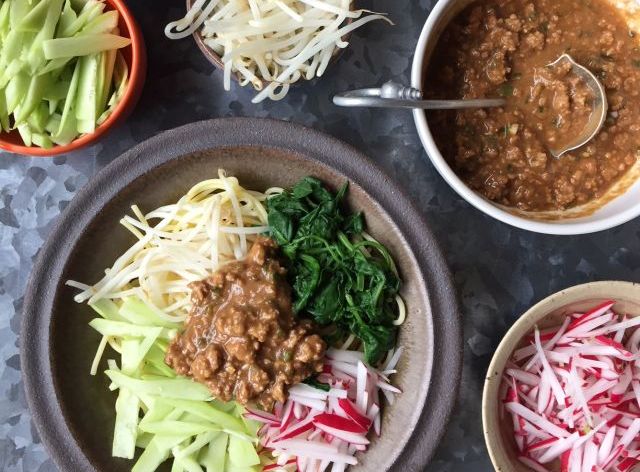
In the 1962 Joyce Chen Cook Book, a few pages after the egg fried rice recipe, was something that made me do a double take. I wasn’t sure what Peking Meat Sauce Noodles were until I recognized the characters for zha jiang mian (炸醬麵, “jah jee-ang mee-an”), a popular Chinese cold noodle dish with thinly cut vegetables and a salty pork and fermented soy bean sauce. If you're unfamiliar with Joyce Chen, read this earlier post.
There are endless variations for the Chinese classic, but what intrigued me about J.C.’s approach was that she boldly suggested cross-cultural cooking and ingredient substitutes. Dried spaghetti pasta are the best stand-in for the authentic chewy hand-pulled Chinese wheat noodles. Japanese miso is a better option than the Chinese bean sauce sold in the States, especially if you combine light and dark (red) miso in a 1:1 ratio. (This point about the bean sauce is spot on because the jarred bean sauce sold at Asian markets is salty and lacking in flavor. Miso is much more complex.)
Her quirky practicality was revealed in the headnote, which comes at the end of each recipes in Chen’s book. There’s a lot of information packed into these two pithy paragraphs describing zha jiang mian, including a catering idea!
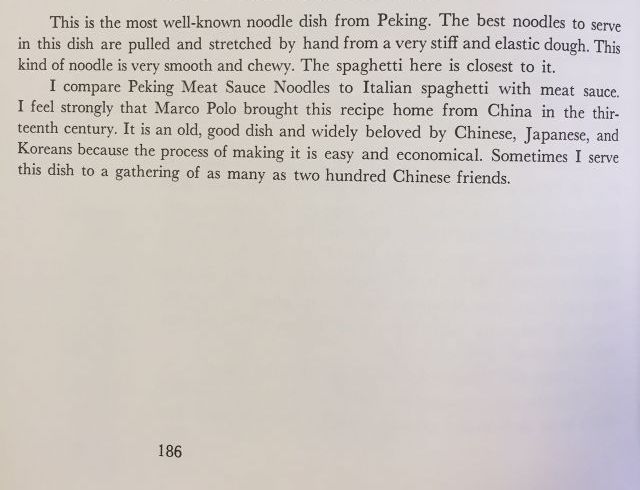
Peking (Beijing) meat sauce noodles are international, enjoyed by the Chinese, Japanese, and Koreans -- a description of the cultural exchange that defines the northeastern part of China, something that we realize today with the North Korean situation. What’s more, note how she accused Marco Polo of borrowing/stealing the idea for spaghetti and meat sauce from Chinese zha jiang mian. Whoa. Quite a statement.
I’d read in Carolyn Phillips’s All Under Heaven that many people have compared zha jiang mian to Italian bolognese. But Chen did not mince words. Indeed, when I made J.C.'s version, it did beg a comparison and connection to the Italian pasta dish. There wasn’t a high ratio of meat sauce to noodles but there was a lot of big umami flavor from the sauce to effectively coat the noodles. Zha jiang mian is not a saucy noodle dish.
The Charms and Challenges of Old Recipes
Cooking from a 55-year-old recipe is fun but also requires you to stretch your brain power a bit. The egg fried rice was relatively simple. This recipe was a bit more complicated because of the way it was written.
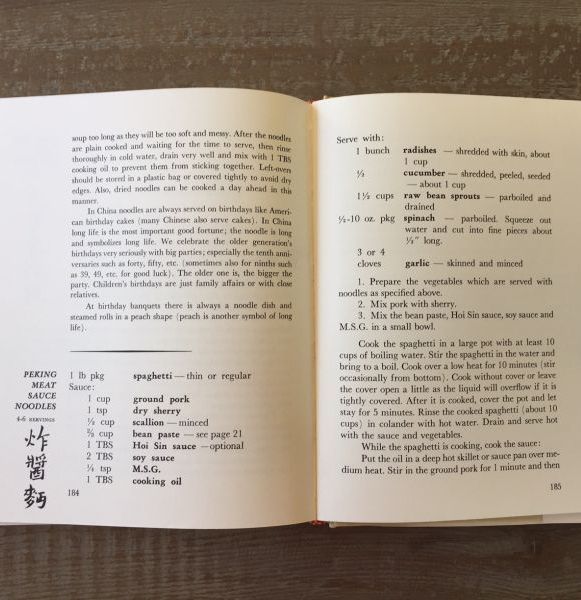
For example, rarely nowadays do you see meat expressed in terms of volume but I know from years of writing recipes, especially for those in Asian Dumplings since I often dealt with ground meat and needed to determine filling yield, that 1 cup of ground meat weighs 8 ounces. Additionally, “½ - 10 oz. pkg” likely meant 5 ounces of spinach, not a one-half to ten ounce package of spinach. Spinach must have been sold in 10-ounce packages in the 1960s. (These are the things recipe writers deal with.)
I’d become familiar with Chen’s recipes enough via her egg fried rice to know that she liked her flavors salty and that she expected people to eat a lot of carbs. In tackling her recipe for zha jiang mian, I lowered the pasta usage and dialed back the salt a bit for the sake of 2017 eating preferences.
For fun, I used gluten-free spaghetti. (If a dish works with GF noodles, it’s going to fabulous with regular noodles, too!) Just so you know, corn-based pastas are strikingly yellow but they also tend to break when reheated. I usually get the all brown-rice kind but was curious about the Barilla brand, which worked out just fine but did break when I microwaved them the next day. Carolyn Phillips suggests flat noodles so you could opt for linguine or fettuccine instead.
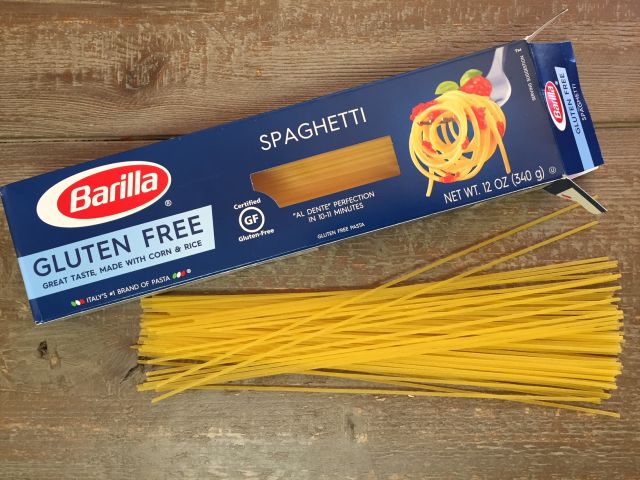
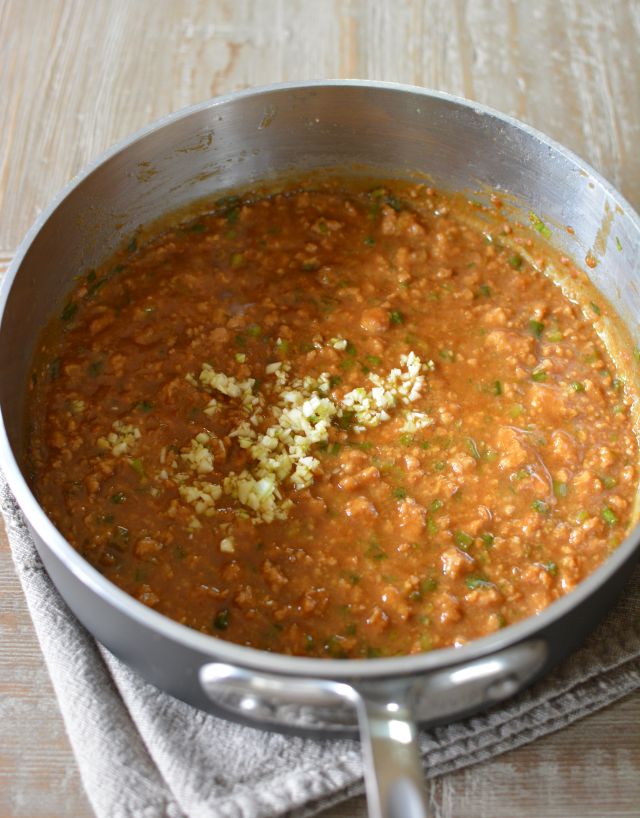
Garlic must have been smaller and/or weaker in flavor in the 1960s. J.C. called for mincing 3 or 4 cloves of garlic and then adding the raw ingredient to the dish at the end. I opted for adding the garlic to the sauce at the end of the line. You should be willing to make this for a date night or party without having to hand out breath mints.
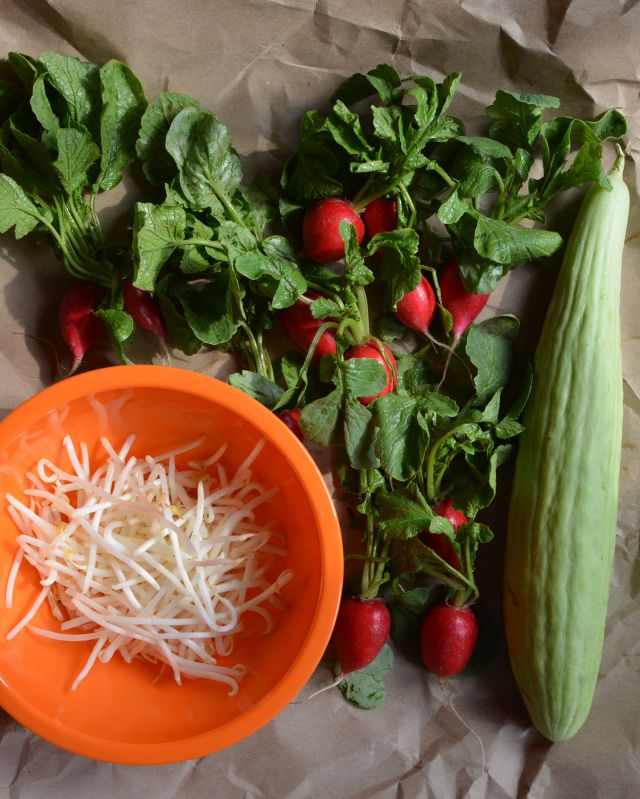
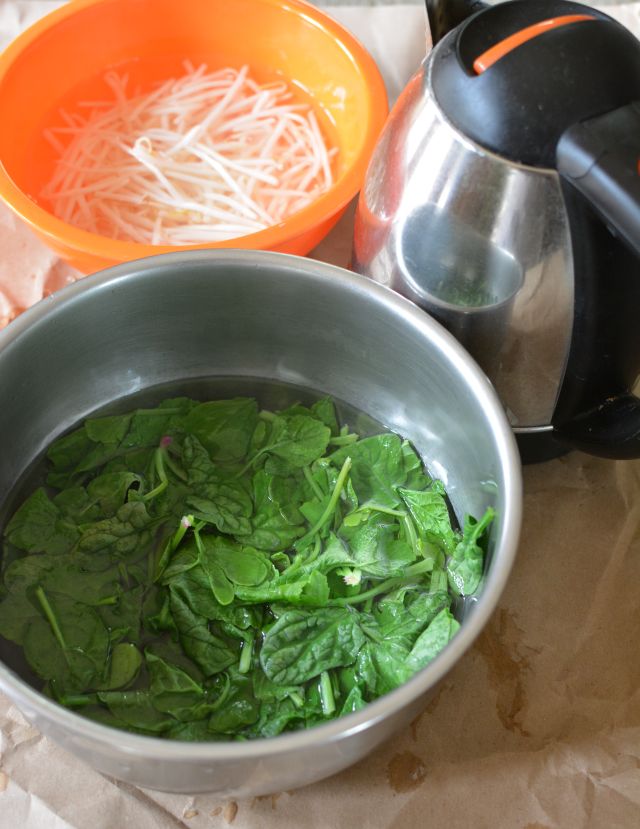
If you have radishes with tender, perky greens, use them for no waste cooking. I added baby spinach to match the radish greens size and to skip having to chop the greens. And, to easily parboil the greens, I heated up a kettle of water and poured it over the vegetables. You may also parboil the vegetables in the water heated up to cook the pasta before you cook the pasta. A noodle strainer is handy for such a job.
To keep the dish gluten-free, I used homemade hoisin (the recipe is in The Pho Cookbook) and gluten-free soy sauce. Yes, I included MSG but as you see, there are options below for substitutes. Or, you may omit the flavor enhancer. Miso and hoisin have lots of umami built in so the flavor enhancer doesn’t play a pivotal role like it does in the egg fried rice.
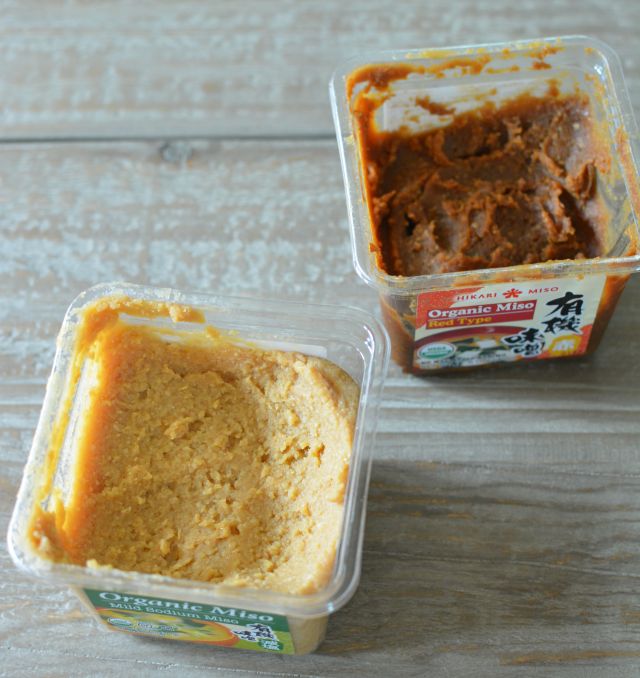
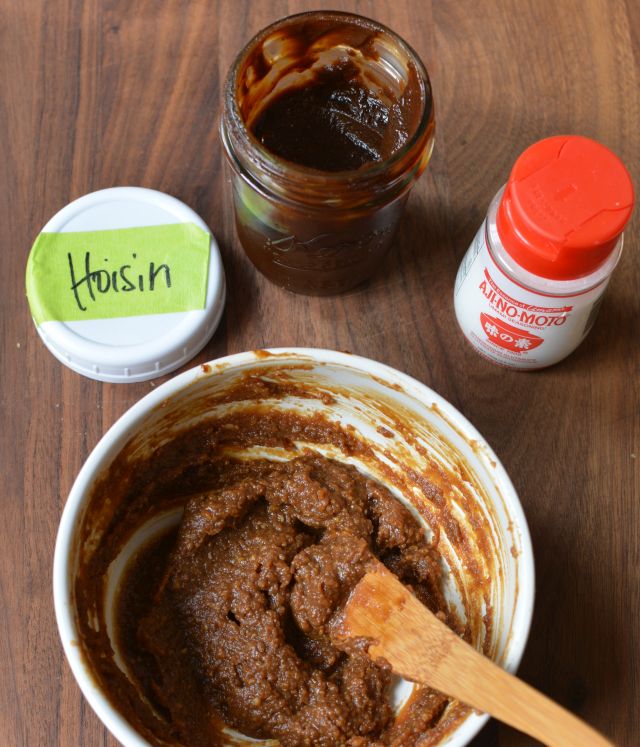
Joyce Chen’s zha jiang mian has good flavor on its own. When I wanted some heat, I added a plop of chile garlic sauce or drizzle of chile oil. You can portion things out for guests or be lazy like me and just lay out all the components for people to assemble their own! I served mine in large shallow bowls, like what you'd serve pasta in. A fork and spoon made things easy to mix and eat. So there's another Chinese-Italian connection.
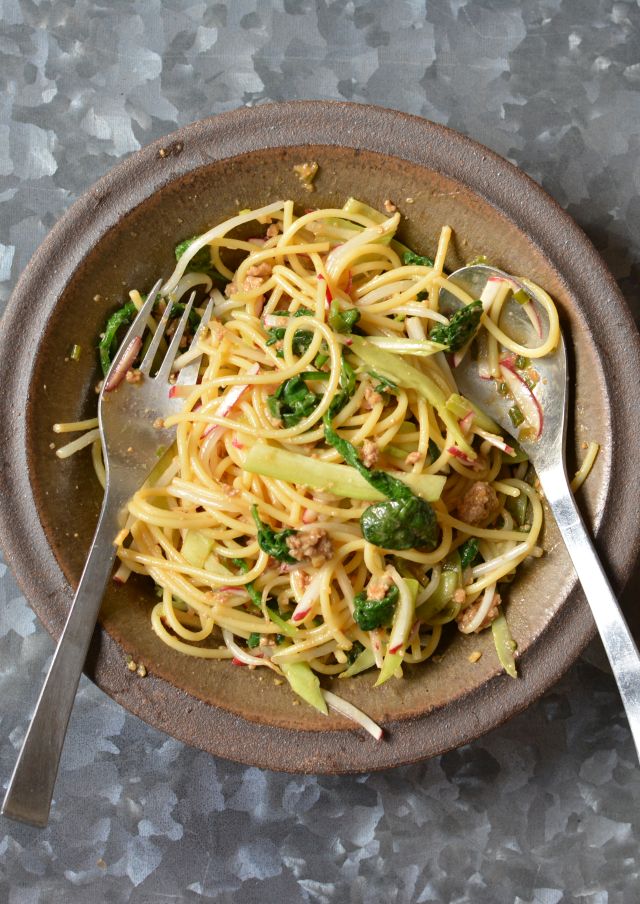
There have been times when I’ve worked through a recipe and realized that it was not written with care. Joyce Chen put so much effort into getting Americans to try her ideas and flavors. Sure there are tweaks and kinks to work out half a century later but at its core, the recipes in the Joyce Chen Cook Book remain solid. Years from now, I hope that’s true for my recipes and books.
Peking Meat Sauce Noodles (Zha Jiang Mian)
Yield 4 servings
Ingredients
- 8 to 9 ounces dried spaghetti, regular or gluten-free
- 5 to 6 ounces baby spinach leaves and/or radish greens
- 1 large handful bean sprouts
- 5 or 6 red radishes, thinly sliced then cut into matchsticks (1 cup total)
- 2 Persian cucumbers or ½ English or Armenian cucumber, seeded and cut into matchsticks
- 6 ounces (¾ cup) ground pork or chicken thigh
- Scant 1 teaspoon dry sherry or Shaoxing rice wine
- 3 tablespoons light (white) miso
- 3 tablespoons red (aka) miso
- 1 ½ teaspoons hoisin (optional)
- 1 tablespoon regular or gluten-free soy sauce
- Scant ¼ teaspoon MSG, ½ teaspoon mushroom seasoning powder, or 1 teaspoon nutritional yeast powder (optional)
- 2 teaspoons canola or other neutral oil
- ⅓ cup lightly packed finely chopped green onion, white and green parts
- Generous ½ cup water
- 2 cloves garlic, minced (2 teaspoons)
- Chile oil, chile garlic sauce, sambal oelek, sriracha
Instructions
- Cook the spaghetti in a large pot of boiling water until chewy-tender. Drain, rinse, and set aside to drain well.
- Put the spinach and bean sprouts in two separate bowls. Add very hot water (I use a kettle to heat the water) to just cover. Let sit for 1 to 3 minutes (longer for the sprouts), until softened. Drain separately and set aside with the radishes and cucumber.
- Mix the ground meat with the sherry. Combine the two kinds of miso, hoisin, soy sauce, and MSG (or other seasoning powder). Keep near the stove.
- Set a deep skillet or shallow saucepan over medium heat. Add the oil. When shimmering, add the seasoned pork. Stir vigorously with a fork to break up the meat into small pieces. When well broken up, add the green onion, stirring constantly. Cook for 45 to 60 seconds longer before adding the miso mixture.
- Once the miso and meat are well combined, add the water. Adjust the heat to low. Let gently cook for 2 minutes (expect no bubbling action) to combine and slightly darken. Turn off the heat, then stir in the garlic. Cool a few minutes, taste and if needed, add a tiny splash of water to thin out. Set aside. Use warm or slightly above room temperature.
- To serve, you may set out the noodles, meat sauce, bean sprouts, cucumber, spinach, and radish for people to compose their own bowls. Or, divide the components up among four (4) individual pasta or noodle bowls and let people mix things up themselves. Alternatively, make one giant bowl and toss at the table and serve. Offer chile oil or sauce for people to add heat. Spoon and fork are my utensils of choice.
Notes
Adapted from the Joyce Chen Cook Book (Lippincott, 1962)
Courses Lunch, Dinner
Cuisine Chinese













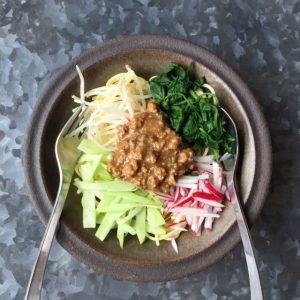




Jim says
I love your critique and analysis of these older recipes. It is very insightful and gives one license to utilize the same approach when reviewing "any" recipe. I will definitely give this one a try soon.
Andrea Nguyen says
So many universal "truths" lie in recipes! Thank you!
Elaine says
Given the era, I wonder if she could have meant a package of FROZEN spinach. lol
Andrea Nguyen says
Maybe! But why parboil it?
Alexandra Christensen says
Thank you for writing about Joyce Chen's book! I recently found it for free in a take-one-leave-one library and have been so excited to try out some of these dishes!! I've loved reading her book, not just for the recipes, but to get such a clear glimpse into this woman's mind and though processes... it's wonderful! This will be my first recipe of hers that I've tried, so I'm so glad to have found someone else's process to help me along!
Andrea Nguyen says
Hooray! Thank your for taking the book and giving it a home. She was a remarkable woman! Enjoy cooking from it.